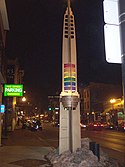Lesben- und Schwulenviertel

Als Lesben- und Schwulenviertel (auch Schwulenviertel; engl.: gay neighborhood, gay village, gayborhood) werden Stadtviertel bezeichnet, die sich durch eine ausgeprägte lesbisch-schwule Subkultur auszeichnen. Typisch sind ein hoher schwuler und lesbischer Bevölkerungsanteil sowie eine auf diese Gruppen ausgerichtete Infrastruktur, wie beispielsweise Bars, Kneipen, Nachtclubs, Saunen, Restaurants, Vereinsräume, Beratungszentren, Buchhandlungen und Videotheken.[1] In der wissenschaftlichen Forschung werden Lesben- und Schwulenviertel insbesondere in Queer Studies und Stadtforschung thematisiert.
Geschichte

Lesben- und Schwulenviertel wurden in den westlichen Industriestaaten in der zweiten Hälfte des 20. Jahrhunderts für Ortsfremde als solche erkennbar, entstanden jedoch Jahrzehnte vorher. Vor der Verbreitung der Lesben- und Schwulenbewegung waren solche Gebiete einer breiteren Öffentlichkeit eher unbekannt, oftmals wegen der strafrechtlichen Situation, richteten sich jedoch in Nischen von Großstädten ein. So berichtet der Historiker George Chauncey von der Bowery als eine solche Nische in New York City um die Wende vom 19. zum 20. Jahrhundert, die bis zu den 1920er Jahren durch Harlem und Greenwich Village ersetzt wurde.[2] Auch Marc Stein sagt über Philadelphia aus, dass es Konzentrationen sowohl von Lesben als auch von Schwulen in den 1940ern, -50ern, und -60ern gegeben hat, die zum Teil überlappten, und Wohnraum, kommerziellen Raum, wie auch öffentlichen Raum umfassten.[3]
- Straßenschild im Lesben- und Schwulenviertel von Philadelphia mit Regenbogen
- Ausgang des U-Bahnhofs Beaudry im Lesben- und Schwulenviertel von Montreal
- Christopher Park in Greenwich Village mit dem „Gay Liberation Monument“ von George Segal, das an den „Stonewall-Aufstand“ von 1969 erinnern soll.
- Als ein Treffpunkt schwulen Lebens Berlins literarisch z. B. von Klaus Mann (Der fromme Tanz) und Christopher Isherwood beschrieben: Die Gegend um Nollendorfplatz und Motzstraße

Literatur
- Manuel Castells: The City and the Grassroots: A Cross-Cultural Theory of Urban Social Movements. University of California Press, Berkeley, Los Angeles 1983.
- John D’Emilio: Making Trouble: Essays on Gay History, Politics, and the University. Routledge, New York, London 1992.
- Jeffrey Escoffier: American Homo: Community and Perversity. University of California Press, Berkeley, Los Angeles, London 1998.
- Richard Florida: The Rise of the Creative Class: And How It’s Transforming Work, Leisure, Community und Everyday Life. Perseus Books Group, New York 2002.
- Benjamin Forest: West Hollywood as Symbol: The Significance of Place in the Construction of a Gay Identity. In: Environment and Planning D: Society and Space. Band 13, 1995, S. 133–157.
- Moira Rachel Kenney: Remember, Stonewall was a Riot: Understanding Gay and Lesbian Experience in the City. In: Leoni Sandercock (Hrsg.): Making the Invisible Visible. University of California Press, Berkeley / Los Angeles / London 1998, Kapitel 5, S. 120–132.
- Mickey Lauria, Lawrence Knopp: Toward an Analysis of the Role of Gay Communities in the Urban Renaissance. In: Urban Geography. Band 6, 1985, S. 152–169.
- Martin P. Levine: Gay Ghetto. In: Martin Levine (Hrsg.): Gay Men: The Sociology of Male Homosexuality. Harper & Row, New York / Hagerstown / San Francisco / London 1979, S. 182–204.
- Brian Ray, Damaris Rose: Cities of the Everyday: Socio-Spatial Perspectives on Gender, Difference, and Diversity. In: Trudi Bunting, Pierre Filion (Hrsg.): Canadian Cities in Transition: The Twenty-First Century. Zweite Ausgabe. Oxford University Press, Oxford 2000, S. 507–512.
Weblinks
- gayScout mit einer Liste der „Top-Gay-Städte“
Quellen
- ↑ M. P. Levine: Gay Ghetto. In: Journal of Homosexuality. Band 4, 1979, S. 364.
- ↑ George Chauncey: Gay New York: Gender, Urban Culture, and the Making of the Gay World. Basic Books, New York 1994, S. 227.
- ↑ Marc Stein: City of Brotherly and Sisterly Loves: Lesbian and Gay Philadelphia, 1945–1972. University of Chicago Press, 2000, S. 21.
Auf dieser Seite verwendete Medien
Autor/Urheber: maha-online, Lizenz: CC BY-SA 2.0
Motzstraßenfest 2006 (Kalckreuthstrasse)
Autor/Urheber: Thomas Ledl, Lizenz: CC BY-SA 4.0
Saint Catherine Street, rainbow, Montreal
photograph of the interior of the world nightclub in new york's east village
Autor/Urheber: Bhuck, Lizenz: CC BY-SA 3.0
Philadelphia streetsign for 12th Street at the corner of Walnut Street in Washington Square West neighborhood. Displays rainbow flag as symbol of the neighborhood's LGBT identity.
Autor/Urheber: Frank Buchalski aus Dallas, United States, Lizenz: CC BY 2.0
One of the landmark rainbow pylons along North Halsted Avenue in Chicago, Illinois Boystown gay village in Lakeview East.
Boystown
Autor/Urheber: Beyond My Ken, Lizenz: CC BY-SA 4.0
Christopher Park, located in Sheridan Square in the triangle formed by Christopher, Grove and West 4th Streets in the Greenwich Village neighborhood of Manhattan, New York City, was created on April 5, 1837 after the city condemned property which had been destroyed by fire two years earlier. A restoration of the park was undertaken by the Friends of Christopher Park beginning in 1983, supervised by the landscape architect Paul Winslow, and costing $130,000. The park re-opened in 1986. In 1992 George Segal's statue Gay Liberation was installed in the park. (Source: "Christopher Park" on the NYC Department of Parks & Recreation website)
Autor/Urheber: Pinkpasty, Lizenz: CC BY 4.0
http://www.gayhistorycornwall.com Front cover of Fagbutts, a local gay community newsletter started in 2006 in Cornwall, UK by LGBT equality campaigner Malcolm Lidbury. Devon & Cornwall police threatened legal action if the gay community newsletter continued to be published. It ceased publication in 2007. 2015 Malcolm Lidbury as a CHILD Sex Abuse Survivor having been in a pedophile ring when he was a child from age 6-10yrs submitted witness testimony to the UK statutory CSA Inquiry set up by Home Secretary Theresa May 'Goddard Inquiry'. So brutal & abusive had been his experience as a gay man been of homophobic police over many years, he placed his witness testimony online out of complete distrust of the authorities http://www.csainquiry.blogspot.com










